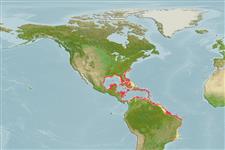Common names from other countries
Environment: milieu / climate zone / depth range / distribution range
Ecología
marino asociado a arrecife; rango de profundidad 3 - 40 m (Ref. 9626). Subtropical; 39°N - 23°S, 99°W - 30°W
Western Atlantic: Chesapeake Bay, through the Gulf of Mexico and Caribbean southward to Brazil. Including Antilles (Ref. 26938).
Length at first maturity / Tamaño / Peso / Age
Maturity: Lm 18.3, range 11 - 23.23 cm
Max length : 53.0 cm TL macho / no sexado; (Ref. 40637); common length : 30.0 cm TL macho / no sexado; (Ref. 3798); peso máximo publicado: 4.4 kg (Ref. 4699)
Espinas dorsales (total) : 12; Radios blandos dorsales (total) : 17; Espinas anales: 3; Radios blandos anales: 9. Side of head has narrow blue stripes; scales above lateral line much larger than those below (Ref. 26938). Scale rows just below lateral line oblique; color variable but usually light yellowish (Ref. 13442).
Found in dense aggregations during the day on patch reefs, around coral formations, or on sandy bottoms (Ref. 9710). Juveniles common in Thalassia testudinum beds (Ref. 5217). Feeds on crustaceans, small mollusks, and small fishes. Frequently exhibits a territorial 'kissing' display in which two contenders push each other on the lips with their mouths wide open (Ref. 9710). Marketed fresh. Has been reared in captivity (Ref. 35420).
Oviparous, distinct pairing during breeding (Ref. 205).
Courtenay, W.R. and H.F. Sahlman, 1978. Pomadasyidae. In W. Fischer (ed.) FAO species identification sheets for fishery purposes. Western Central Atlantic (Fishing Area 31), Volume 4. FAO, Rome. (Ref. 3798)
IUCN Red List Status (Ref. 130435)
CITES (Ref. 128078)
Not Evaluated
Threat to humans
Reports of ciguatera poisoning (Ref. 30303)
Human uses
Pesquerías: escaso valor comercial; pesca deportiva: si; Acuario: Acuarios públicos
Herramientas
Special reports
Download XML
Fuentes de Internet
Estimates based on models
Preferred temperature (Ref.
115969): 23.4 - 28, mean 25.9 (based on 342 cells).
Phylogenetic diversity index (Ref.
82804): PD
50 = 0.5000 [Uniqueness, from 0.5 = low to 2.0 = high].
Bayesian length-weight: a=0.01413 (0.01172 - 0.01702), b=2.99 (2.95 - 3.03), in cm Total Length, based on LWR estimates for this species (Ref.
93245).
Nivel trófico (Ref.
69278): 3.8 ±0.0 se; based on diet studies.
Resiliencia (Ref.
120179): Medio, población duplicada en un tiempo mínimo de 1.4-4.4 años (K=0.16-0.35; tm=2; tmax=13; Fec=64,000).
Fishing Vulnerability (Ref.
59153): High vulnerability (62 of 100).
